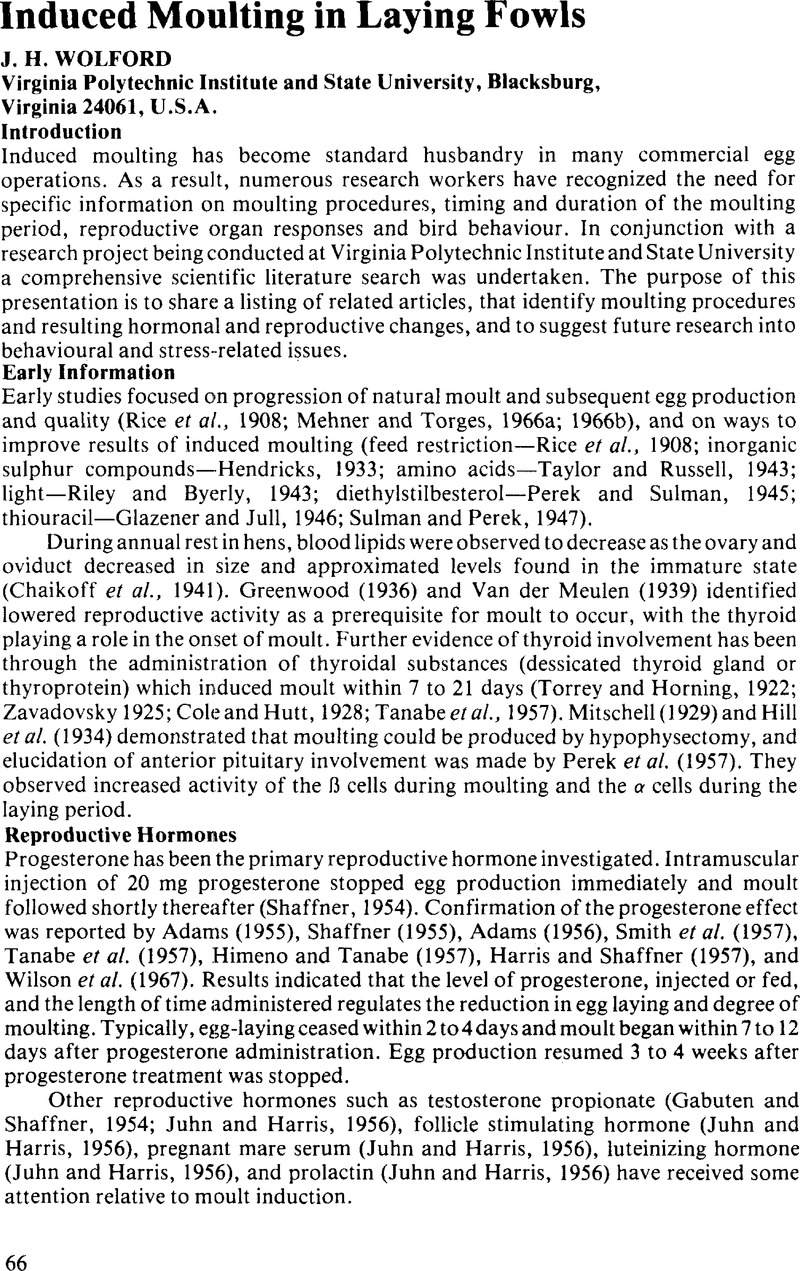Crossref Citations
This article has been cited by the following publications. This list is generated based on data provided by Crossref.
Rose, S. P.
and
Campbell, V.
1986.
Fatness of laying hens and induced moulting regimens.
British Poultry Science,
Vol. 27,
Issue. 3,
p.
369.
Karunajeewa, H.
1987.
A review of current poultry feeding systems and their potential acceptability to animal welfarists.
World's Poultry Science Journal,
Vol. 43,
Issue. 1,
p.
20.
ZELENKA, D.J.
JONES, D.E.
DUNNINGTON, E.A.
and
SIEGEL, P.B.
1987.
Selection for Body Weight at Eight Weeks of Age.
Poultry Science,
Vol. 66,
Issue. 1,
p.
41.
SEKIMOTO, K.
IMAI, K.
SUZUKI, M.
TAKIKAWA, H.
HOSHINO, N.
and
TOTSUKA, K.
1987.
Thyroxine-Induced Molting and Gonadal Function of Laying Hens.
Poultry Science,
Vol. 66,
Issue. 4,
p.
752.
DICKERMAN, R.W.
and
BAHR, J.M.
1989.
Molt Induced by Gonadotropin-Releasing Hormone Agonist as a Model for Studying Endocrine Mechanisms of Molting in Laying Hens.
Poultry Science,
Vol. 68,
Issue. 10,
p.
1402.
Karunajeewa, H.
Abu‐Serewa, S.
and
Harris, Pamela A.
1989.
Effects of an induced pause in egg production and supplementation of the diet with iron on egg shell colour, quality and performance of brown egg layers.
British Poultry Science,
Vol. 30,
Issue. 2,
p.
257.
Aggrey, S.E.
Kroetzl, H.
and
Foelsch, D.W.
1990.
Behaviour of laying hens during induced moulting in three different production systems.
Applied Animal Behaviour Science,
Vol. 25,
Issue. 1-2,
p.
97.
BAHR, JANICE M.
and
JOHNSON, PATRICIA A.
1991.
Reproduction in Domestic Animals.
p.
555.
John Savory, C.
and
Fisher, Richard D.A.
1992.
Influence of a period of ‘freeze-feeding’ on behaviour of growing layer pullets.
Applied Animal Behaviour Science,
Vol. 35,
Issue. 1,
p.
55.
Dickerman, R.W.
Wise, T.H.
and
Bahr, J.M.
1992.
Effect of ovarian regression and molt on plasma concentrations of thymosin β4 in domestic hens (Gallus domesticus).
Domestic Animal Endocrinology,
Vol. 9,
Issue. 4,
p.
297.
Savory, C. John
Seawright, Elaine
and
Watson, Amanda
1992.
Stereotyped behaviour in broiler breeders in relation to husbandry and opioid receptor blockade.
Applied Animal Behaviour Science,
Vol. 32,
Issue. 4,
p.
349.
Bell, Donald D.
and
Kuney, Douglas R.
1992.
Effect of Fasting and Post-Fast Diets on Performance in Molted Flocks.
Journal of Applied Poultry Research,
Vol. 1,
Issue. 2,
p.
200.
Jacquet, J. M.
Seigneurin, F.
and
De Reviers, M.
1993.
Induced moulting in cockerels: Effects on sperm production, plasma concentrations of luteinising hormone, testosterone and thyroxine, and on pituitary sensitivity to luteinising hormone‐releasing hormone.
British Poultry Science,
Vol. 34,
Issue. 4,
p.
765.
Hussein, Ahmed S.
1996.
Induced moulting procedures in laying fowl.
World's Poultry Science Journal,
Vol. 52,
Issue. 2,
p.
175.
Murphy, Mary E.
1996.
Avian Energetics and Nutritional Ecology.
p.
158.
Heryanto, B.
Yoshimura, Y.
Tamura, T.
and
Okamoto, T.
1997.
Involvement of apoptosis and lysosomal hydrolase activity in the oviducal regression during induced molting in chickens: a cytochemical study for end labeling of fragmented DNA and acid phosphatase.
Poultry Science,
Vol. 76,
Issue. 1,
p.
67.
Heryanto, B
Yoshimura, Y
and
Tamura, T
1997.
Cell proliferation in the process of oviducal tissue remodeling during induced molting in hens.
Poultry Science,
Vol. 76,
Issue. 11,
p.
1580.
Yoshimura, Y.
Okamoto, T.
and
Tamura, T.
1997.
Localisation of MHC class II, lymphocytes and immunoglobulins in the oviduct of laying and moulting hens.
British Poultry Science,
Vol. 38,
Issue. 5,
p.
590.
Tona, K.
Bamelis, F.
De Ketelaere, K.B.
Bruggeman, V.
and
Decuypere, E.
2002.
Effect of Induced Molting on Albumen Quality, Hatchability, and Chick Body Weight from Broiler Breeders.
Poultry Science,
Vol. 81,
Issue. 3,
p.
327.
Chowdhury, V.S.
and
Yoshimura, Y.
2002.
Cell Proliferation and Apoptosis in the Anterior Pituitary of Chicken during Inhibition and Resumption of Laying.
General and Comparative Endocrinology,
Vol. 125,
Issue. 1,
p.
132.



